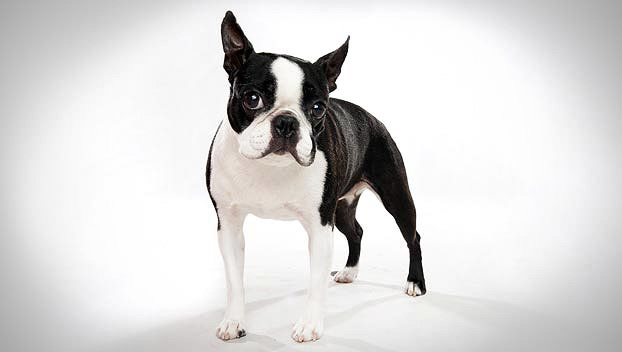
The Breed History
The Boston terrier arose from crosses between white English terriers
and English bulldogs; first offspring trace back to the year 1870.
Hooper's Judge was the foundation stud. The original crosses
were considerably larger than today's standard. Since the breed
originated in Boston, this name was chosen to identify this terrier
breed. The first AKC registry entries occurred in 1893.
Breeding for Function
This dog was bred as a companion dog, though his origins provide
him with capacity for a plucky terrier's courage and defense.
Physical Characteristics
Height at Withers: 15-17" (38-43 cm)
Weight: 3 size types within the breed:
Up to 15 lb (< 7 kg), 15-19 lb (7-8.5 kg), 20-25 lb (9-11 kg)
Coat: Short, fine, flat glossy coat is black, brindle or seal with well
demarcated and specifically distributed striking white markings.
Seal is a black appearance with a red tone in bright light. Brindle is
preferred as the base color.
Longevity: 13-14 years.
Points of Conformation: The compact, sturdy, squarely built
body is broad in front across the chest. Boston terriers possess a
short body and brachycephalic head with a pronounced stop. The
expression is gentle but alert, skull is broad between the ears and
without wrinkles, eyes are very wide set with a dark brown color,
and the small erect ears are sometimes cropped. Ear leather is fine
and hair covering is minimal. The short blocky muzzle is wider than
long, the nose is black. Bite is square to mildly undershot. Nictitans
should not be visible, and palpebral margins should be dark, the
neck is slightly arched, head carriage is high. The topline is level,
thorax moderately deep with ribs well sprung, and the tail is short
(less than 1/4 of the distance to the tarsus) and tapers with straight
or screw ending, and is carried low. The limbs are straight, dewclaws
may be taken off, and feet have well knuckled toes, are compact and
are small. Gait is agile and straight with good rear driving power.
Recognized Behavior Issues and Traits
Boston terriers are described as being of high intelligence with a
stubborn streak, alert, very active, playful, and having a very gentle
disposition. Moderate exercise requirements, low grooming needs,
ability to get along with gentle children and other pets are hallmarks
of the breed. Will alarm bark, but they are not considered protectors.
Boston terriers are suitable for home and apartment living, and they
do not tolerate temperature extremes. They may snore and snort.
Some may be picky eaters. They are minimal shedders.
Normal Physiologic Variations
The breed tends to have small litters, with three considered normal.
In Great Britain, 92.3% of Boston Terrier litters are delivered via
C-section.
Drug Sensitivities
None reported
Inherited Diseases
Hip Dysplasia and Legg-Calve Perthes Disease: Polygenically
inherited traits causing degenerative hip joint disease and arthritis.
OFA reports 13.5% affected with hip dysplasia.
Cataracts: Two types of cataracts are identified in the breed: An
autosomal recessive early-onset hereditary cataract (EHC) has
an onset before 6 months and complete opacity by 2 years of
age. A genetic test is available for EHC. A late-onset hereditary
cataract (LHC) has an onset after 4-5 years of age with a variable
progression, and an unknown mode of inheritance. Anterior
or posterior intermediate and punctate cataracts occur in the
breed. In one large study, 11.11% of Boston terriers had cataracts.
Identified in 8.66% of Boston terriers CERF examined by veterinary
ophthalmologists between 2000-2005. Dorn reports a 2.14x odds
ratio versus other breeds. One study showed a 4.2x odds ratio
versus other breeds. CERF does not recommend breeding any
Boston Terrier with a cataract.
Patella Luxation: Polygenically inherited laxity of patellar
ligaments, causing luxation, lameness, and later degenerative joint
disease. Treat surgically if causing clinical signs. OFA reports 5.6%
affected. Dorn reports a 2.14x odds ratio versus other breeds.
Another study reports a 4.2x odds ratio versus other breeds.
Elbow Dysplasia: Polygenically inherited trait causing elbow
arthritis. Too few Boston Terriers have been screened by OFA to
determine an accurate frequency.
Disease Predispositions
Brachycephalic Complex: The brachycephalic complex includes
stenotic nares, elongated soft palate, everted laryngeal saccules,
laryngeal collapse, and occasionally hypoplastic trachea. Boston
terriers comprise 15% of all dogs diagnosed with hypoplasia of the trachea. Dorn reports a 10.68x odds ratio for elongated soft palate
versus other breeds. Unknown mode of inheritance.
Dystocia: Boston terriers are prone to difficult birthing, due to both
a dorsoventrally flattened pelvic canal and large fetuses with big
heads.
Distichiasis: Abnormally placed eyelashes that irritate the
cornea and conjunctiva. Can cause secondary corneal ulceration.
Identified in 3.82% of Boston terriers CERF examined by veterinary
ophthalmologists between 2000-2005.
Persistent Pupillary Membranes: Strands of fetal remnant
connecting; iris to iris, cornea, lens, or involving sheets of tissue. The
later three forms can impair vision, and dogs affected with these
forms should not be bred. Identified in 3.61% of Boston Terriers CERF
examined by veterinary ophthalmologists between 2000-2005.
Glaucoma: Ocular condition causing increased pressure within
the eyeball, and secondary blindness due to damage to the
retina. Diagnose with tonometry and gonioscopy. Can be a
primary condition or secondary to cataract or lens luxation. Dorn
reports a 2.12x odds ratio for developing glaucoma versus other
breeds. Another report found a 4.1x odds ratio for secondary
glaucoma versus other breeds. Diagnosed in 2.88% of Boston
terriers presented to veterinary teaching hospitals. CERF does not
recommend breeding any Boston Terrier with glaucoma.
Allergic Dermatitis: Inhalant or food allergy. Presents with pruritis
and pyotraumatic dermatitis. Reported at an increased frequency in
Boston terriers.
Corneal Dystrophy: Epithelial-stromal, and endothelial forms occur
in the breed. Endothelial form is associated with progressive corneal
edema, which can lead to bullous keratopathy and corneal erosions. Age
of onset 6-13 years. Treatment is symptomatic and palliative. Epithelialstromal
form is identified in 2.63% of Boston terriers, and endothelial
form in 0.21% of Boston Terriers CERF examined by veterinary
ophthalmologists between 2000-2005. CERF does not recommend
breeding any Boston Terrier with endothelial corneal dystrophy.
Hypothyroidism: Inherited autoimmune thyroiditis. 1.9% positive
for thyroid auto-antibodies based on testing at Michigan State
University. (Ave. for all breeds is 7.5%).
Hyperadrenocorticism (Cushing's Disease): Caused by a functional
adrenal or pituitary tumor. Clinical signs may include increased
thirst and urination, symmetrical truncal alopecia, and abdominal
distention. Dorn reports a 5.60x odds ratio versus other breeds.
Deafness: Congenital deafness can be unilateral or bilateral. Associated
with Irish pattern and piebald pigmentation. Diagnose by BAER testing.
Unknown mode of inheritance.OFA reports 1.9% affected.
Vitreous Degeneration: Liquefication of the vitreous gel which
may predispose to retinal detachment, glaucoma, and blindness.
Identified in 1.22% of Boston Terriers CERF examined by veterinary
ophthalmologists between 2000-2005.
Hypospadias: Almost 25% of all diagnoses of hypospadias (an
abnormal opening of the urethra) occur in Boston terriers. There is
a 15:1 male to female prevalence. Cryptorchidism or intersexuality
can also accompany the condition.
Atresia Ani (Imperforate Anus): An increased incidence of this
congenital condition is reported in the breed, with a frequency of
0.07%, and an odds ratio of 13.77x. Treatment is surgery.
Cleft Lip and Palate: Boston terriers may have an increased
frequency of cleft lip and palate versus other breeds.
Hemivertebra and Butterfly Vertebra: May cause scoliosis, pain or
spinal cord compression if severe. Unknown mode of inheritance.
Perineal Hernia: Boston terriers have a predisposition to
developing perineal hernias. Treatment is surgery.
Uveal Cysts: Boston terriers have a higher frequency of uveal cysts
than other breeds, with a mean age of cyst development of 6.8 years.
Cataract Resorption-induced Uveitis: Spontaneous cataract
resorption, and associated lens-induced uveitis primarily occurs
in young Boston Terriers. Medical control of the lens-induced
uveitis by use of mydriatics and, infrequently, topical and systemic
corticosteroids is essential.
Vascular Ring Anomaly: Reported at an increased frequency in the
breed. Causes regurgitation and megaesophagus when solid food is
first fed. Correct with surgery.
Glial Tumors: Boston terriers may have a predisposition to nervous
tissue tumors of glial origin.
Anasarca, Calcinosis Circumscripta, Cerebellar Vermian
Hypoplasia, Craniomandibular Osteopathy, Cryptorchidism,
Demodicosis, Entropion, Hydrocephalus, Keratoconjunctivitis
Sicca, Mitral valve Disease, Pelger-Huet Anomaly, Progressive
Retinal Atrophy, Prolapsed Gland of Nictitans, Pyloric Stenosis,
Sacrocaudal Dysgenesis, Spina Bifida, Ulcerative Keratitis, and
Wry Mouth are reported.
Isolated Case Studies
Muscular Dystrophy: Sarcoglycan-deficient muscular dystrophy
has been reported in several young, male and female Boston
Terriers. Affected dogs present with muscle atrophy or hypertrophy,
gait abnormalities, dysphagia, and dramatically increased CK, AST,
and ALT activities.
Dandy-Walker-Like Syndrome: Case report of an affected
Boston terrier puppy. Congenital disorder causing cerebellar ataxia
and other CNS signs due to cysts arising from the 4th ventricle,
dysgenesis of the cerebellar vermis, and hydrocephalus of the 3rd
and lateral ventricles. A previous report of this syndrome in Boston
terriers suggests the problem may be inherited in this breed.
Tubular Colonic Duplication: A six-month-old, intact female
Boston terrier presented with clinical signs of increased frequency of
defecation, tenesmus, and constipation, which had been present since
birth. A diagnosis of tubular colonic duplication was made via contrast
radiography and colonoscopy. The condition was corrected surgically.
Choroid Plexus Carcinoma and Meningeal Carcinomatosis: A
6-year-old neutered female Boston terrier had a slow onset of bilateral
visual loss. On magnetic resonance imaging (MRI) there were multiple
cyst-like structures found in the parenchyma of the cerebrum,
cerebellum and brainstem. Histopathologically the diagnosis was a
choroid plexus carcinoma with meningeal carcinomatosis.
Neuroblastoma: A mediastinal neuroblastoma was found in a
15-mth-old Boston terrier with dyspnea. The tumor compressed
adjacent lung and invaded the cervical spinal cord.
Genetic Tests
Tests of Genotype: Direct test for early-onset hereditary cataract
(EHC) is available from the Animal Health Trust (UK) and VetGen.
Direct test for coat color alleles is available from VetGen.
Tests of Phenotype: CHIC Certification: Required testing includes
CERF eye examination, patella examination, and BAER test for
deafness. See CHIC website (caninehealthinfo.org).
Recommended tests include hip and elbow radiographs, thyroid
profile including autoantibodies, and cardiac evaluation.
Miscellaneous
- Breed Name Synonyms: Boston, Boston Bulldog, Boston Bull,
American Bull Terrier (historical name before 1891). The American
Gentleman (nickname)
- Registries: AKC, UKC, CKC, KCGB (Kennel Club of Great Britain),
ANKC (Australian National Kennel Club), NKC (National Kennel Club)
- AKC rank (year 2008): 17 (10,930 dogs registered)
- Internet resources: Boston Terrier Club of America:
bostonterrierclubofamerica.org
Boston Terrier Club of Canada:
bostonterrierclubofcanada.com
Photo Gallery of Breed - Boston Terrier - Dog Breed








 Animalia Life
Animalia Life